Metal halide perovskites facilitate a new photovoltaic solar cell technology: They show a high absorption coefficient, are cheap to produce and simple to manufacture. In addition, they have the potential to achieve higher efficiencies than silicon-based solar cells.
Defects in crystals influence performance
However, researchers are still trying to understand why the photovoltaic conversion of metal halide perovskites is so high. Atomic scale point defects in the crystal structure normally reduce the efficiency of solar photovoltaic devices. Therefore, it is necessary to identify and confirm different defect types, in order to design manufacturing processes for optimum performance.
Until recently, researchers have only been able to gain insight into the probable point defects using theoretical calculations alone. Now, British and Swedish have performed positron annihilation lifetime spectroscopy at the MLZ’s positron source NEPOMUC to detect these defects and identify respective defect types and their probable charge states.
Positrons provide information on type of defect
Positrons annihilate with electrons after implantation, which leads to the emission of radiation after a certain time. Dr. Marcel Dickmann of the Universität der Bundeswehr München measured this radiation using the Pulsed Low-Energy Positron System (PLEPS) at the MLZ: “We can determine the type and concentration of the defects in the crystal by measuring the positrons’ lifetime using the emitted radiation.”
Positrons are trapped inside crystal vacancy defects. Since their lifetime is a measure of the local electron density, measuring the time between implantation and annihilation can be used to characterize specific vacancy defect types. Using a pulsed, monoenergetic beam, positron lifetime measurements permit the depth-profiling of vacancy-related defects from the near-surface down to depths of a few micrometers. Theoretical calculations of positron lifetimes were compared to measurements and enabled the missing atom site to be identified.
Orignial publication
D. J. Keeble, J. Wiktor, S. K. Pathak, L. J. Phillips, M. Dickmann, K. Durose, H. J. Snaith, W. Egger, Identification of lead vacancy defects in lead halide perovskites, Nat. Commun. 12, 5566 (2021) DOI: 10.1038/s41467-021-25937-1
The experiments were carried out at the instrument PLEPS of the NEPOMUC positron source.
